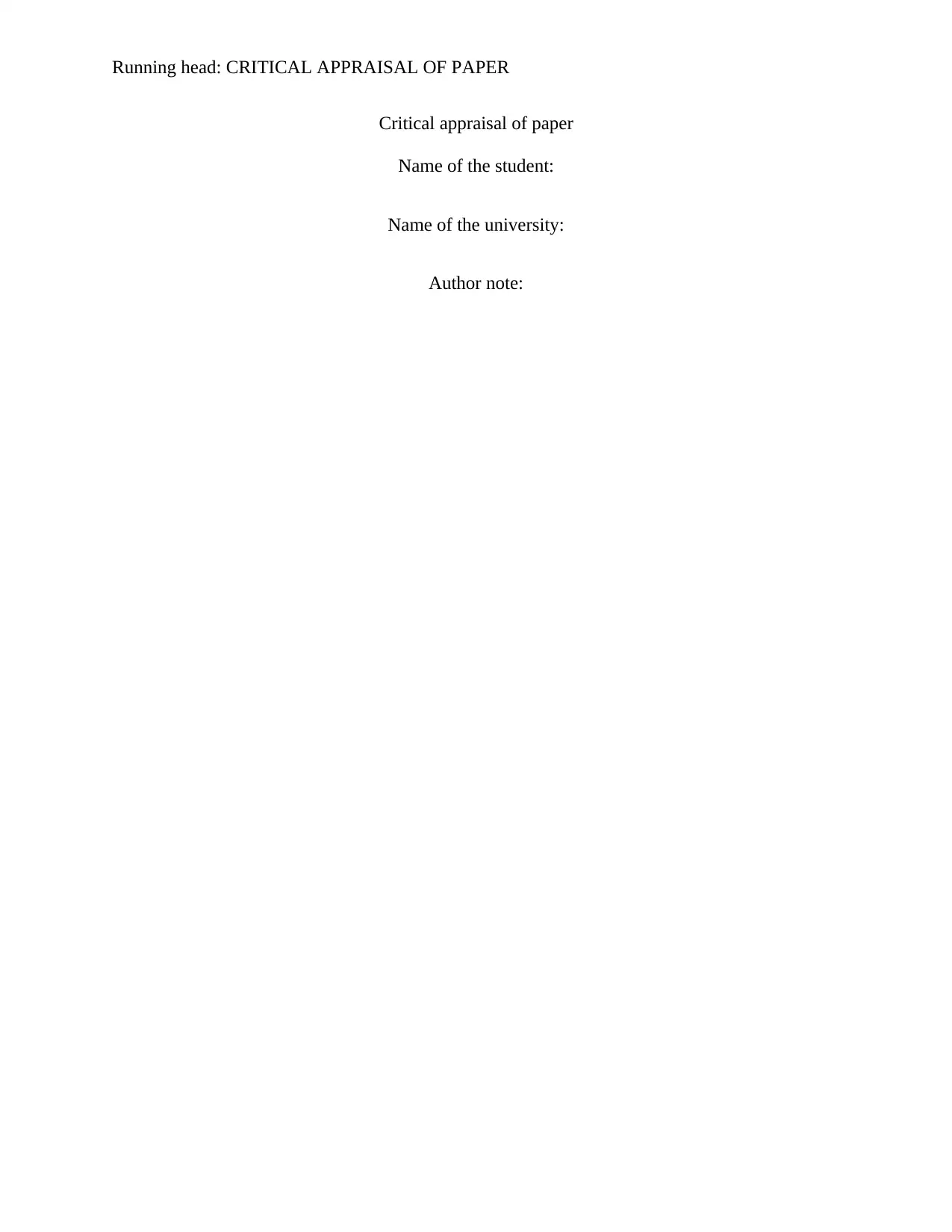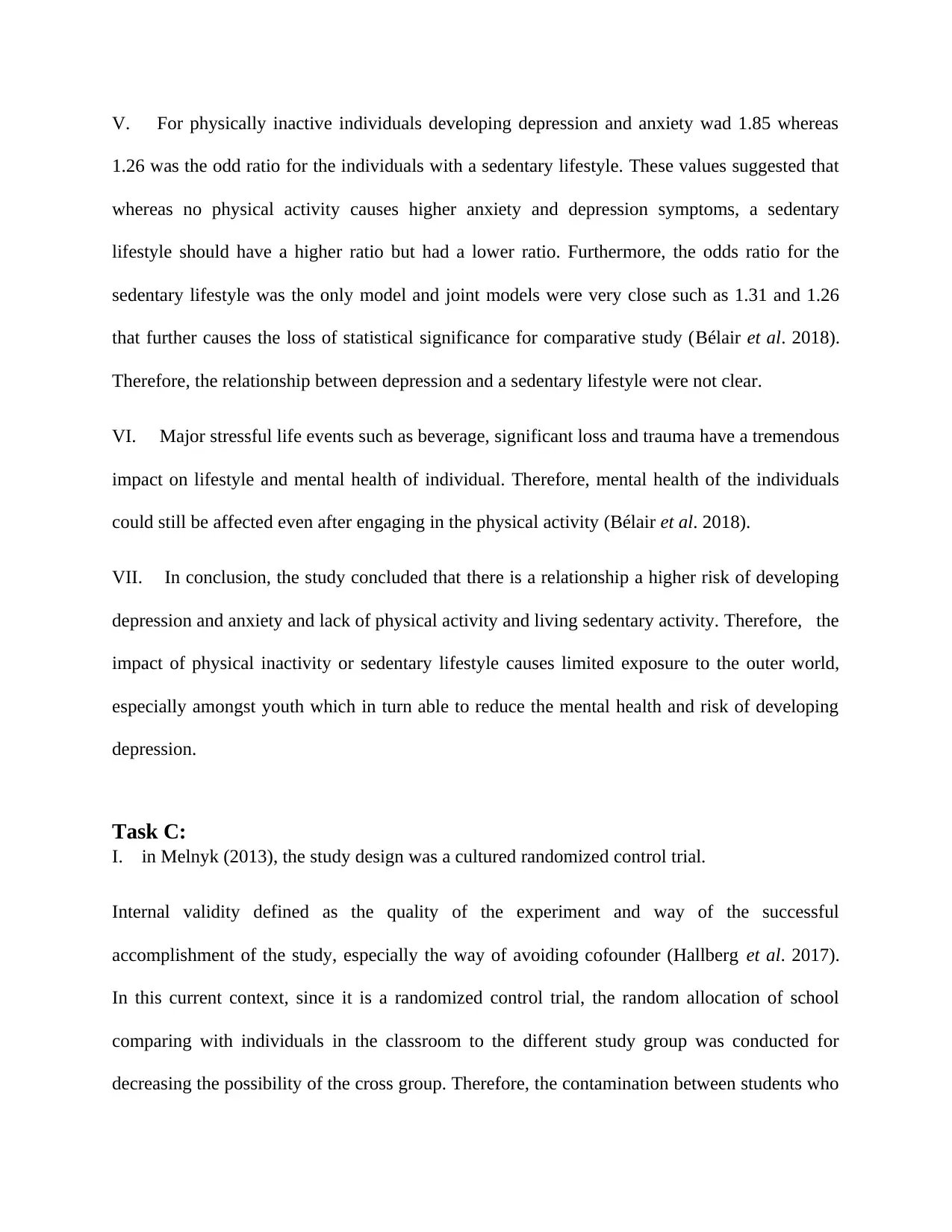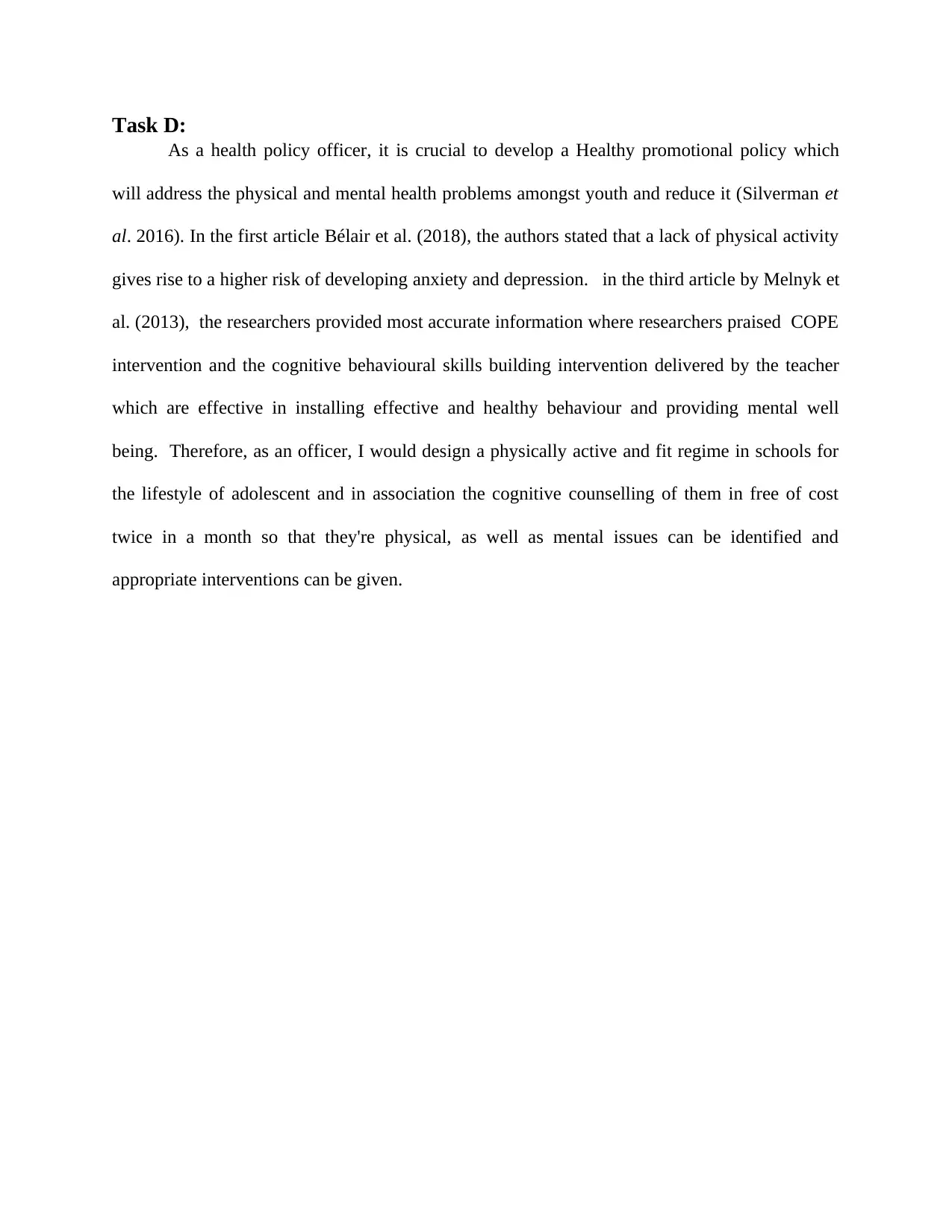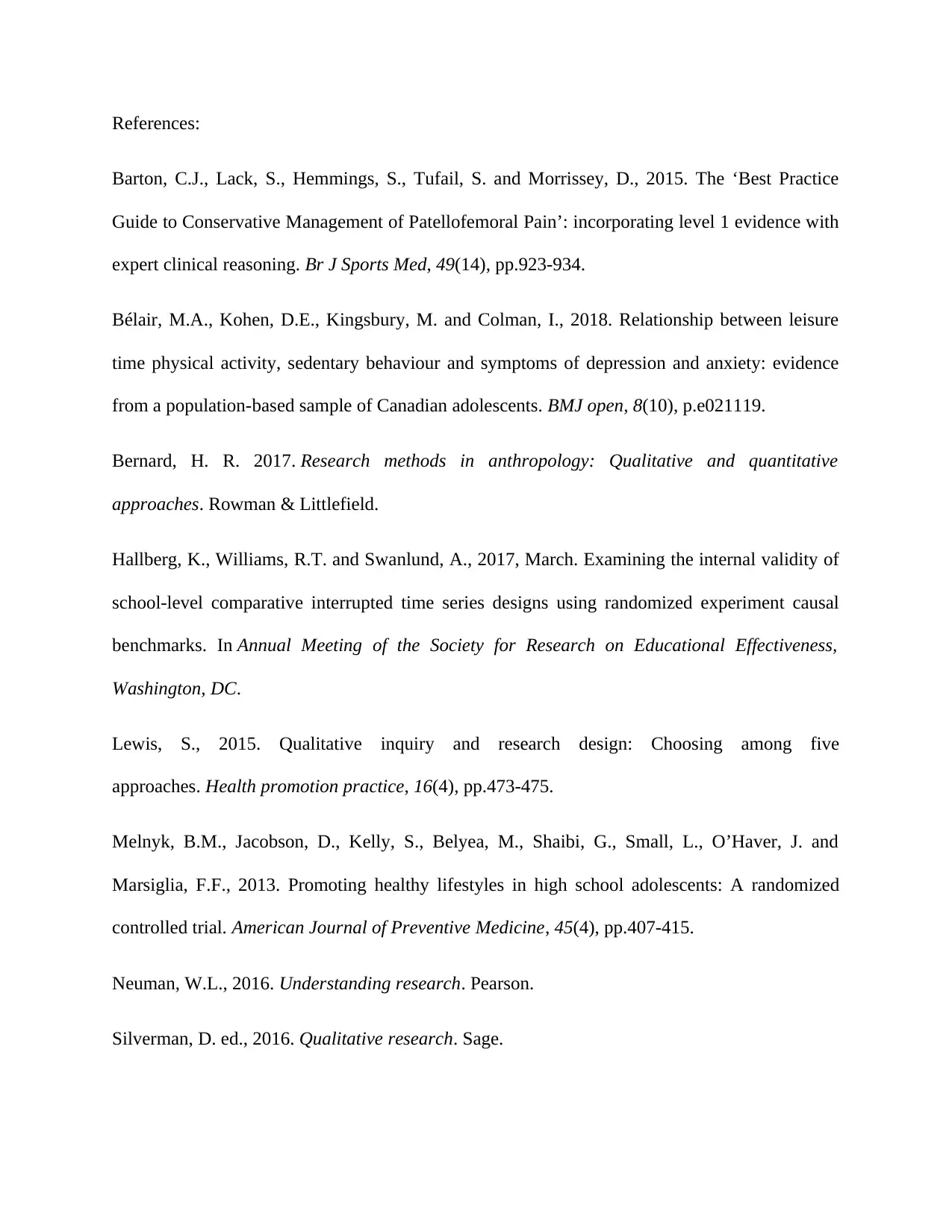HBS108 Interpreting and Evaluating Health Evidence: A Report
VerifiedAdded on 2023/04/22
|7
|1497
|214
Report
AI Summary
This report provides a critical appraisal of research articles focusing on the relationship between physical activity and mental health, particularly in adolescents. It examines a cross-sectional study by Bélair et al. (2018) which investigates the association between leisure time physical activity, sedentary behavior, and symptoms of depression and anxiety. The report also analyzes a clustered randomized control trial by Melnyk et al. (2013) which assesses the effectiveness of the COPE program in promoting healthy lifestyles among high school students. Key aspects of the appraisal include evaluating study designs, measurement scales, odds ratios, internal and external validity, and potential biases. The report concludes with recommendations for health policy, advocating for the implementation of physically active regimes and cognitive counseling in schools to address the mental health needs of young people. Desklib provides access to similar assignments and past papers for students.

Running head: CRITICAL APPRAISAL OF PAPER
Critical appraisal of paper
Name of the student:
Name of the university:
Author note:
Critical appraisal of paper
Name of the student:
Name of the university:
Author note:
Paraphrase This Document
Need a fresh take? Get an instant paraphrase of this document with our AI Paraphraser

Table of Contents
Task A:.............................................................................................................................................3
Task C:.............................................................................................................................................4
Task D:.............................................................................................................................................6
Task A:.............................................................................................................................................3
Task C:.............................................................................................................................................4
Task D:.............................................................................................................................................6

Task A:
I. In Bélair et al. (2018), the study design of the article was cross-sectional study.
As discussed by the level of evidence framework, the study is rated as a level four of
evidence (Barton et a. 2015). By using anxiety scores and level of depression, the study defined
the association between physical activity and mental health. In Bélair et al. (2018), the odds of
moderate to severe symptoms of depression as well as depression were compared with
respondents having no symptoms.
II. measurement scales were used by researchers for the responses such as “ I am too fearful
or nervous” were respondent rate for assessing the effectiveness of these statements described
the respondents by using statements such as never or not true’, ‘sometimes or somewhat true’ or
‘often or very true’ the researcher also used Cronbach alpha scales for measurement.
III. The interval measurement scale was used as the measurement scale used for two different
measurements such as physically active and physically inactive. The interval measurement scale
is a numerical scale for analyzing orders as well as the exact difference between values. The
Rationale behind choosing this scale is that it considered distance as meaning full data and for
this case, the measurements were done considering time gaps (Neuman 2016). Therefore,
interval type of the study was appropriate for measurement.
IV. The odds ratio of 1.85 defined as the measurement for the occurrence of depression. For
the physically inactive group the odd chance is 1.85 for developing depression and anxiety
amongst individuals with no physical activity the 95% confidence limit (1.42 to 2.41) suggested
that 95% of the sample would be included in the parametric mean every time when study would
replicate with the similar randomly selected population for the confidence interval.
I. In Bélair et al. (2018), the study design of the article was cross-sectional study.
As discussed by the level of evidence framework, the study is rated as a level four of
evidence (Barton et a. 2015). By using anxiety scores and level of depression, the study defined
the association between physical activity and mental health. In Bélair et al. (2018), the odds of
moderate to severe symptoms of depression as well as depression were compared with
respondents having no symptoms.
II. measurement scales were used by researchers for the responses such as “ I am too fearful
or nervous” were respondent rate for assessing the effectiveness of these statements described
the respondents by using statements such as never or not true’, ‘sometimes or somewhat true’ or
‘often or very true’ the researcher also used Cronbach alpha scales for measurement.
III. The interval measurement scale was used as the measurement scale used for two different
measurements such as physically active and physically inactive. The interval measurement scale
is a numerical scale for analyzing orders as well as the exact difference between values. The
Rationale behind choosing this scale is that it considered distance as meaning full data and for
this case, the measurements were done considering time gaps (Neuman 2016). Therefore,
interval type of the study was appropriate for measurement.
IV. The odds ratio of 1.85 defined as the measurement for the occurrence of depression. For
the physically inactive group the odd chance is 1.85 for developing depression and anxiety
amongst individuals with no physical activity the 95% confidence limit (1.42 to 2.41) suggested
that 95% of the sample would be included in the parametric mean every time when study would
replicate with the similar randomly selected population for the confidence interval.
⊘ This is a preview!⊘
Do you want full access?
Subscribe today to unlock all pages.

Trusted by 1+ million students worldwide

V. For physically inactive individuals developing depression and anxiety wad 1.85 whereas
1.26 was the odd ratio for the individuals with a sedentary lifestyle. These values suggested that
whereas no physical activity causes higher anxiety and depression symptoms, a sedentary
lifestyle should have a higher ratio but had a lower ratio. Furthermore, the odds ratio for the
sedentary lifestyle was the only model and joint models were very close such as 1.31 and 1.26
that further causes the loss of statistical significance for comparative study (Bélair et al. 2018).
Therefore, the relationship between depression and a sedentary lifestyle were not clear.
VI. Major stressful life events such as beverage, significant loss and trauma have a tremendous
impact on lifestyle and mental health of individual. Therefore, mental health of the individuals
could still be affected even after engaging in the physical activity (Bélair et al. 2018).
VII. In conclusion, the study concluded that there is a relationship a higher risk of developing
depression and anxiety and lack of physical activity and living sedentary activity. Therefore, the
impact of physical inactivity or sedentary lifestyle causes limited exposure to the outer world,
especially amongst youth which in turn able to reduce the mental health and risk of developing
depression.
Task C:
I. in Melnyk (2013), the study design was a cultured randomized control trial.
Internal validity defined as the quality of the experiment and way of the successful
accomplishment of the study, especially the way of avoiding cofounder (Hallberg et al. 2017).
In this current context, since it is a randomized control trial, the random allocation of school
comparing with individuals in the classroom to the different study group was conducted for
decreasing the possibility of the cross group. Therefore, the contamination between students who
1.26 was the odd ratio for the individuals with a sedentary lifestyle. These values suggested that
whereas no physical activity causes higher anxiety and depression symptoms, a sedentary
lifestyle should have a higher ratio but had a lower ratio. Furthermore, the odds ratio for the
sedentary lifestyle was the only model and joint models were very close such as 1.31 and 1.26
that further causes the loss of statistical significance for comparative study (Bélair et al. 2018).
Therefore, the relationship between depression and a sedentary lifestyle were not clear.
VI. Major stressful life events such as beverage, significant loss and trauma have a tremendous
impact on lifestyle and mental health of individual. Therefore, mental health of the individuals
could still be affected even after engaging in the physical activity (Bélair et al. 2018).
VII. In conclusion, the study concluded that there is a relationship a higher risk of developing
depression and anxiety and lack of physical activity and living sedentary activity. Therefore, the
impact of physical inactivity or sedentary lifestyle causes limited exposure to the outer world,
especially amongst youth which in turn able to reduce the mental health and risk of developing
depression.
Task C:
I. in Melnyk (2013), the study design was a cultured randomized control trial.
Internal validity defined as the quality of the experiment and way of the successful
accomplishment of the study, especially the way of avoiding cofounder (Hallberg et al. 2017).
In this current context, since it is a randomized control trial, the random allocation of school
comparing with individuals in the classroom to the different study group was conducted for
decreasing the possibility of the cross group. Therefore, the contamination between students who
Paraphrase This Document
Need a fresh take? Get an instant paraphrase of this document with our AI Paraphraser

are in the same School observed that further would have affected the interval validity of the
study.
In the study, the external validity of the study is high since 11 high school districts in the
south-western US were selected in the study sample.
II. In the study, Melnyk et al. (2013), the independent variable of the study include COPE, the
cognitive behavioural skills building interventions with 20 minutes of physical activity. The
dependent variable of the study includes healthy lifestyle behaviour as well as body mass index.
III. gender ( male), race( black, white, Asian), ethnicity BMI categories ( healthy weight and
underweight) CDC and steps per days are the crucial factors that highlighted the significant
difference between two groups (Melnyk et al. 2013). The benchmark for considering statistical
significance is 25 units or more than 25 units for the difference.
IV. The most common selection of bias for the clustered randomized control trial that also
observed in the study is the loss of follow up (Lewis 2015). The bias significantly impacted the
internal validity of the study and reduces the authenticity of the data finds.
V. The purpose of the study was to conduct research on short term and long term efficacy of
COPE, attention control program and Lifestyles of teen on the behaviour, lifestyle as well as
mental health of the respondents. The research suggested that COPE is effective in enhancing
short term and long term outcomes of high schools and enhancing other outcomes for teenagers
who are at higher risk of developing other chronic diseases (Melnyk et al. 2013). Therefore, the
program was effective in achieving its aim.
study.
In the study, the external validity of the study is high since 11 high school districts in the
south-western US were selected in the study sample.
II. In the study, Melnyk et al. (2013), the independent variable of the study include COPE, the
cognitive behavioural skills building interventions with 20 minutes of physical activity. The
dependent variable of the study includes healthy lifestyle behaviour as well as body mass index.
III. gender ( male), race( black, white, Asian), ethnicity BMI categories ( healthy weight and
underweight) CDC and steps per days are the crucial factors that highlighted the significant
difference between two groups (Melnyk et al. 2013). The benchmark for considering statistical
significance is 25 units or more than 25 units for the difference.
IV. The most common selection of bias for the clustered randomized control trial that also
observed in the study is the loss of follow up (Lewis 2015). The bias significantly impacted the
internal validity of the study and reduces the authenticity of the data finds.
V. The purpose of the study was to conduct research on short term and long term efficacy of
COPE, attention control program and Lifestyles of teen on the behaviour, lifestyle as well as
mental health of the respondents. The research suggested that COPE is effective in enhancing
short term and long term outcomes of high schools and enhancing other outcomes for teenagers
who are at higher risk of developing other chronic diseases (Melnyk et al. 2013). Therefore, the
program was effective in achieving its aim.

Task D:
As a health policy officer, it is crucial to develop a Healthy promotional policy which
will address the physical and mental health problems amongst youth and reduce it (Silverman et
al. 2016). In the first article Bélair et al. (2018), the authors stated that a lack of physical activity
gives rise to a higher risk of developing anxiety and depression. in the third article by Melnyk et
al. (2013), the researchers provided most accurate information where researchers praised COPE
intervention and the cognitive behavioural skills building intervention delivered by the teacher
which are effective in installing effective and healthy behaviour and providing mental well
being. Therefore, as an officer, I would design a physically active and fit regime in schools for
the lifestyle of adolescent and in association the cognitive counselling of them in free of cost
twice in a month so that they're physical, as well as mental issues can be identified and
appropriate interventions can be given.
As a health policy officer, it is crucial to develop a Healthy promotional policy which
will address the physical and mental health problems amongst youth and reduce it (Silverman et
al. 2016). In the first article Bélair et al. (2018), the authors stated that a lack of physical activity
gives rise to a higher risk of developing anxiety and depression. in the third article by Melnyk et
al. (2013), the researchers provided most accurate information where researchers praised COPE
intervention and the cognitive behavioural skills building intervention delivered by the teacher
which are effective in installing effective and healthy behaviour and providing mental well
being. Therefore, as an officer, I would design a physically active and fit regime in schools for
the lifestyle of adolescent and in association the cognitive counselling of them in free of cost
twice in a month so that they're physical, as well as mental issues can be identified and
appropriate interventions can be given.
⊘ This is a preview!⊘
Do you want full access?
Subscribe today to unlock all pages.

Trusted by 1+ million students worldwide

References:
Barton, C.J., Lack, S., Hemmings, S., Tufail, S. and Morrissey, D., 2015. The ‘Best Practice
Guide to Conservative Management of Patellofemoral Pain’: incorporating level 1 evidence with
expert clinical reasoning. Br J Sports Med, 49(14), pp.923-934.
Bélair, M.A., Kohen, D.E., Kingsbury, M. and Colman, I., 2018. Relationship between leisure
time physical activity, sedentary behaviour and symptoms of depression and anxiety: evidence
from a population-based sample of Canadian adolescents. BMJ open, 8(10), p.e021119.
Bernard, H. R. 2017. Research methods in anthropology: Qualitative and quantitative
approaches. Rowman & Littlefield.
Hallberg, K., Williams, R.T. and Swanlund, A., 2017, March. Examining the internal validity of
school-level comparative interrupted time series designs using randomized experiment causal
benchmarks. In Annual Meeting of the Society for Research on Educational Effectiveness,
Washington, DC.
Lewis, S., 2015. Qualitative inquiry and research design: Choosing among five
approaches. Health promotion practice, 16(4), pp.473-475.
Melnyk, B.M., Jacobson, D., Kelly, S., Belyea, M., Shaibi, G., Small, L., O’Haver, J. and
Marsiglia, F.F., 2013. Promoting healthy lifestyles in high school adolescents: A randomized
controlled trial. American Journal of Preventive Medicine, 45(4), pp.407-415.
Neuman, W.L., 2016. Understanding research. Pearson.
Silverman, D. ed., 2016. Qualitative research. Sage.
Barton, C.J., Lack, S., Hemmings, S., Tufail, S. and Morrissey, D., 2015. The ‘Best Practice
Guide to Conservative Management of Patellofemoral Pain’: incorporating level 1 evidence with
expert clinical reasoning. Br J Sports Med, 49(14), pp.923-934.
Bélair, M.A., Kohen, D.E., Kingsbury, M. and Colman, I., 2018. Relationship between leisure
time physical activity, sedentary behaviour and symptoms of depression and anxiety: evidence
from a population-based sample of Canadian adolescents. BMJ open, 8(10), p.e021119.
Bernard, H. R. 2017. Research methods in anthropology: Qualitative and quantitative
approaches. Rowman & Littlefield.
Hallberg, K., Williams, R.T. and Swanlund, A., 2017, March. Examining the internal validity of
school-level comparative interrupted time series designs using randomized experiment causal
benchmarks. In Annual Meeting of the Society for Research on Educational Effectiveness,
Washington, DC.
Lewis, S., 2015. Qualitative inquiry and research design: Choosing among five
approaches. Health promotion practice, 16(4), pp.473-475.
Melnyk, B.M., Jacobson, D., Kelly, S., Belyea, M., Shaibi, G., Small, L., O’Haver, J. and
Marsiglia, F.F., 2013. Promoting healthy lifestyles in high school adolescents: A randomized
controlled trial. American Journal of Preventive Medicine, 45(4), pp.407-415.
Neuman, W.L., 2016. Understanding research. Pearson.
Silverman, D. ed., 2016. Qualitative research. Sage.
1 out of 7
Related Documents
Your All-in-One AI-Powered Toolkit for Academic Success.
+13062052269
info@desklib.com
Available 24*7 on WhatsApp / Email
![[object Object]](/_next/static/media/star-bottom.7253800d.svg)
Unlock your academic potential
Copyright © 2020–2025 A2Z Services. All Rights Reserved. Developed and managed by ZUCOL.




